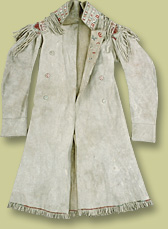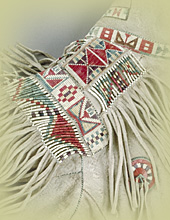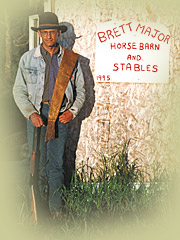 |
Arrival of Strangers - The Last 500 YearsThe MétisEconomy"The women produce the most beautiful garnished work of beads, porcupine quills and silk with which they adorn leather coats, moccasins, pouches, saddles... two hundred carts make the yearly pilgrimage across the prairies, six hundred and fifty miles, to St. Paul [Minnesota]. They are laden with buffalo hides, pemmican, peltries, fur, embroidered leather coats, moccasins, saddles, etc. These they sell or exchange at St. Paul and return again to their secluded homes." - Frank B. Mayer's diary, July 23, 1851, quoted in Bertha L. Heilbron, "Mayer and the Treaty of 1851", Minnesota History Métis men and women were essential to all aspects of the fur trade. Several Hudson's Bay Company and North West Company factors were Métis. As the fur trade and buffalo herds declined in the mid-1800s, Red River Métis began to raise oxen and haul freight in Red River carts between St. Paul, Minnesota, Fort Garry and Edmonton. Métis and First Nations women provided crucial support to the growth of the local and national economy through their bartering skills, the production of pemmican, clothing and footwear, hide processing, small- and large-scale farming industries, and the development of decorative arts and crafts. Since the 1930s, when Métis associations began to be organized, Métis people have again become recognizable participants in the North American economy. Today, Métis are ranchers, cowboys, police officers, firefighters, doctors, lawyers, editors, professors, journalists, computer technicians, historians, writers, engineers, mechanics, artists, actors, museum curators and politicians.
| ||


